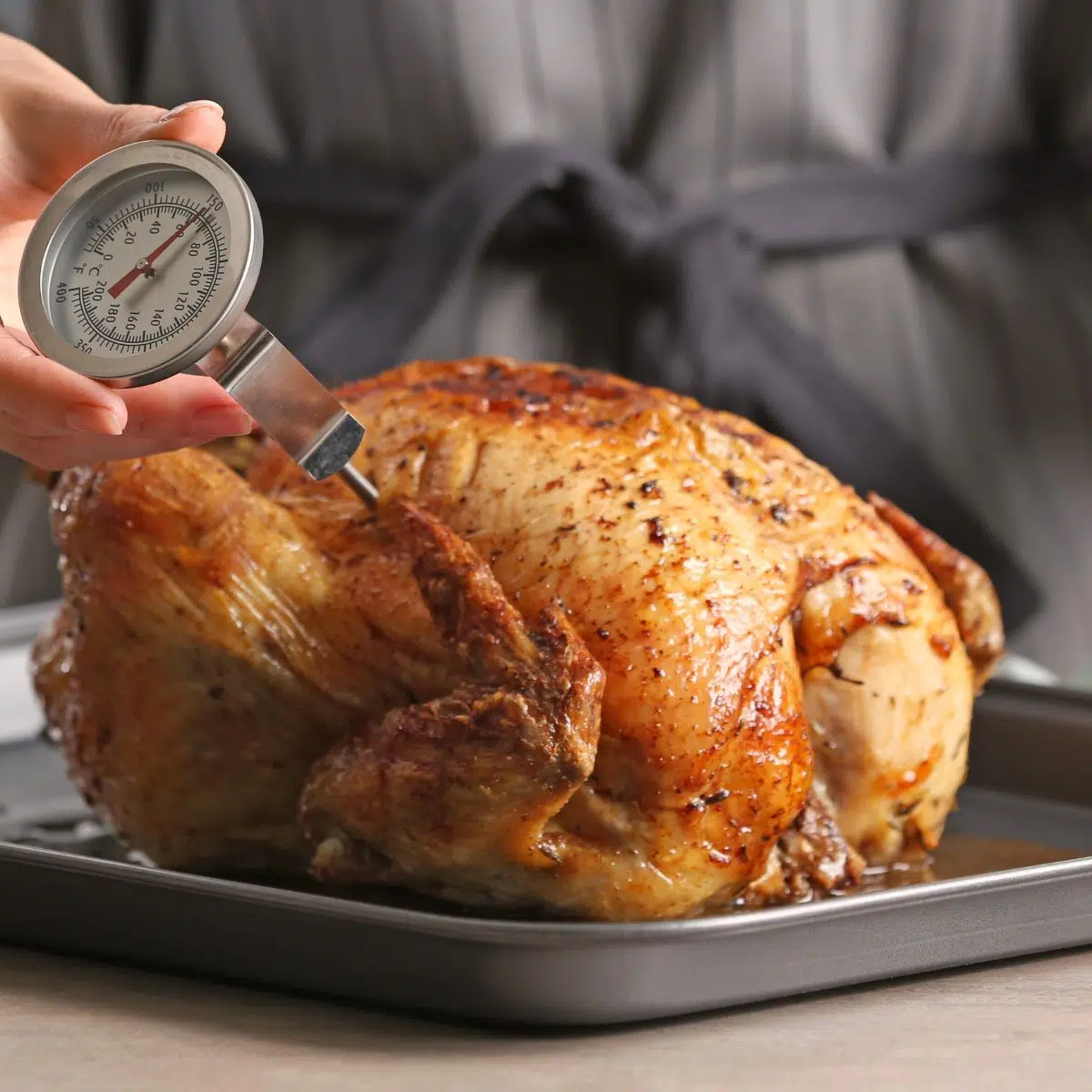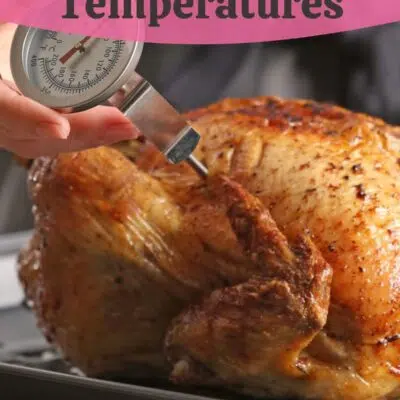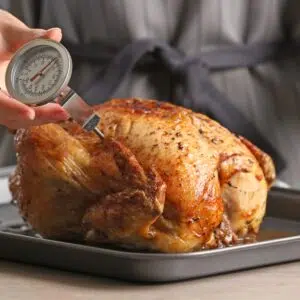Chicken internal temperatures are in place so you can safely enjoy your favorite chicken recipes! No one wants under-cooked chicken just as much as no one wants overcooked chicken. Skip the guessing game and learn how to test your chicken's internal temperature so you can dig-in without worry!
Ideal Chicken Internal Temperature
Chicken is one of the most common meats that we cook at home. However, it is also one of the meats that home cooks are less likely to check the internal temperature of.
This news may be somewhat surprising as cooking chicken to a safe internal temperature is extremely important! Follow all of my tips and tricks to cooking safe, delicious chicken without having to eyeball anything.

Jump to:
Why You Should Check The Internal Temperature Of Chicken
All types of meat are subject to potential bacteria that can cause food-borne illnesses. Therefore, it is important to check the internal temperature of all types of meat. However, due to the additional possibility of salmonella, it is even more important to check that chicken and turkey are fully cooked.
Since turkeys are commonly cooked whole for Thanksgiving, many of us are familiar with checking the internal temp of a turkey using a meat thermometer. However, since chickens are more frequently cooked in individual parts (breasts, thighs, wings, legs) it is less common to think about using a thermometer to check the internal temperature.
Just like a thermometer would be used to check the temperature of a steak though, the same should be done for pieces of chicken.
How To Check The Internal Temperature Of Chicken
Many home cooks rely on the visual test to see if their chicken is done. Simply looking to see if there is any pink left in the center.
Unfortunately, this is not the most reliable way to check if the meat is cooked. Chicken meat could appear to no longer be pink but still not have reached the recommended internal temperature. Moreover, by cutting into the chicken you release all the juice and may be left with a dry piece of meat.
The best way to check the internal temperature of chicken is to use a meat thermometer. If you don't have a meat thermometer yet, I encourage you to add one to your kitchen tools.
A meat thermometer is one of the most important tools you can have in your kitchen. It will ensure that any type of meat you cook is always cooked exactly to the recommended internal temperature.
You can buy a meat thermometer online at places like Amazon. Most stores like Walmart and Target also carry inexpensive thermometers.
How To Use A Meat Thermometer For Chicken
- Insert the thermometer into the thickest part of the chicken.
- Be mindful that you are not in a fat pocket or hitting a bone as this will result in a false reading
- Once the thermometer is inserted, let it sit for about 30 seconds so it can reach the final temperature.
- After getting your initial read, gently pull the thermometer back about a ¼ inch (keeping it inside the chicken)
- Check the temperature at the new location
- If the temperatures at both parts of the chicken match, then the chicken is evenly cooked
- If the temperatures do not match, then the chicken may not have cooked all the way through.
Depending on the type of chicken you are cooking, it may be normal to have different temperatures throughout (such as a whole chicken). However, for a single piece (like a chicken breast) the temperature should be even.
In addition to determining that the chicken has been thoroughly cooked, a meat thermometer also ensures you won't overcook your chicken.
The goal of a delicious chicken is to have a moist and juicy chicken. Therefore, you won't want to overcook it. A meat thermometer helps you avoid this by letting you know exactly when it is ready to remove from the oven.
What Is The Ideal Internal Temperature For Chicken?
When checking the internal temperature of chicken, the standard temperature is 165°F (74°C). This is the minimum temperature at which potential bacteria have been killed by the heat. Once the chicken has reached this minimum temperature then you can feel safe eating & serving it.
While this is the standard temperature recommended for chicken, there are some variations depending on what part of the chicken you are cooking.
Chicken Breast
When cooking only chicken breast aim for the standard 165°F (74°C). Since most chicken breasts are quite thick you can insert the thermometer vertically into the thickest part of the breast.
However, you can also insert the thermometer horizontally through the side of the breast. Using horizontal placement is better for thinner pieces.
Chicken Thighs
Chicken thighs are technically fully cooked at 165°F (74°C). Therefore, you can safely remove the thighs when they reach this point. For ideal flavor and texture though, it is recommended that you cook chicken thighs to 175° (79°C). You can even continue cooking thighs until they reach an internal temperature of 195° (91°C).
The reason for cooking thighs longer is due to the dark meat in the thighs. Dark meat has more connective tissue. Therefore, it needs more time at a higher heat to break down the tissue and create tender meat. Letting the thighs cook longer will result in a juicier and tender piece of chicken.
Chicken Wings & Legs
Chicken wings and legs are the two exceptions to the thermometer rule. There is typically not enough meat on chicken wings to get a good reading. Moreover, the large bone in chicken legs also makes it difficult to get an accurate measurement.
While it is more difficult to use a thermometer for these two cuts of chicken, a thermometer is always the best practice. Therefore, start there and try to get a reading of165°F (74°C).
However, if you are not able to properly use a thermometer then do a visual test. Look for if the meat is shrinking away from the bone. When the meat is shrinking or pulling away from the bone it often indicates that chicken legs and wings are fully cooked.
Whole Roasted Chicken
As shown above, there are two different ideal temperatures for the chicken breast and the thighs. Therefore, when you cook a whole chicken, it is best to check the temperature of both these places.
Begin by first checking the internal temperature of the breasts since this is the thickest part of the chicken. Simply find the thickest area of one breast and insert the thermometer. If you find the thickest part of the whole chicken, you do not need to check both breasts.
Typically, once the chicken breasts have reached a temperature of 165°F (74°C) the thighs have also reached this internal temperature (since they are smaller). Even better, they may have already cooked beyond 165° at this point. Therefore, you will get the nice juiciness of the white meat from the breasts and tender dark meat from the thighs.
While the goal is to have the thighs cook to 175° (79°C). or beyond, you don't necessarily want to continue cooking the whole chicken to achieve this. If you continue to cook the whole chicken once the breast has reached 165°F (74°C). you run the risk of overcooking the chicken. Therefore, with a whole chicken aim for 165°F (74°C) for the final temperature.
Chicken Internal Temperature Reference Chart
| Chicken Part | Oven Temperature | Cooking Time |
|---|---|---|
| Whole Chicken | 350°F | 20 minutes per pound +15 minutes |
| Boneless Chicken Thighs | 425°F | about 35 minutes |
| Bone-in Chicken Thighs | 425°F | about 45 minutes |
| Boneless Chicken Breasts (Large) | 375°F | 20 to 30 minutes |
| Bone-in Chicken Breasts (Large) | 375°F | 35 to 40 minutes |
| Chicken Wings | 400°F | 45 minutes |
| Chicken Legs | 425°F | 40-45 minutes |
| Chicken Tenders | 375°F | 20-25 minutes |
🍗 Tasty Chicken Recipes
- Instant Pot Chicken Drumsticks - An incredible chicken leg dinner doesn't get any easier!
- Grilled Chicken Quarters - These hearty grilled chicken quarters are savory, filling, and delicious!
- Marry Me Chicken - This one-skillet chicken dinner features a creamy Parmesan and sun dried tomato sauce that will have people getting down on one knee!
- Mushroom Swiss Chicken - The classic flavor combination of mushrooms and Swiss cheese makes the perfect topping for chicken!
- Chicken Broccoli Rice Casserole - This cheesy chicken casserole is an easy family dinner that kids love!
- Million Dollar Baked Chicken Breast - This baked chicken breast with cheese and bacon will have you feeling like you won the lottery!
This guide on chicken internal temperatures is all you need to make perfectly cooked chicken! Let us know which of our amazing chicken recipes you'd like to try by leaving us a comment below!
Do you love a recipe you tried? Please leave a 5-star 🌟rating in the recipe card below and/or a review in the comments section further down the page.
Stay in touch with me through social media @ Pinterest, Facebook, Instagram, or Twitter! Subscribe to the newsletter today (no spam, I promise)! Don't forget to tag me when you try one of my recipes!
📖 Recipe Card
Chicken Internal Temperatures: Bag Roasted Chicken (+ Ideal Temps For Other Chicken Recipes)
Ingredients
- 4 lb whole chicken (4-5 pounds)
- 2 tablespoon butter (softened)
- 1 tablespoon chicken seasoning (to taste, try my recipe or use your favorite brand)
(Note: 2x or 3x only changes the ingredient list)
Instructions
- To begin, preheat your oven to 350°F (175°C).
- Pat your chicken dry with paper towels. Rub the butter all over every part of your chicken and then sprinkle it with the chicken seasoning.
- Lift the seasoned chicken by picking it up by the body cavity and sliding it into your opened roasting bag (*see note). Seal the bag with the ties included in the packaging.
- Bake the chicken in your preheated oven at 350°F (175°C) for approximately 20 minutes per pound (*see note). It is done cooking when the internal temperature reads 165°F (74°C).
- Remove the chicken from the oven and allow it to rest for 15 minutes before carving and serving.
Notes
- Cooking times can vary based on whether or not your chicken was allowed to warm slightly (at least 30 minutes at room temperature).
- If your chicken was frozen, make sure that it has fully thawed before getting started.
- The packaging for the roasting bag says to add flour to coat the inside of the bag. However, since we are buttering our chicken it isn't necessary.
- To store: Place any leftovers into an airtight container and store them in the fridge for up to 2 days.
- To freeze: Wrap the chicken tightly and place it into a freezer bag before freezing. Allow it to thaw in the fridge overnight before reheating.
- To reheat: Place leftovers into a baking dish and add some water or broth. Cover the dish with foil and bake it at 350°F (180°C) until heated all the way through.



Frank says
Angela thank you for the discussion regarding internal temps. Specifically I appreciate your insight about a whole roasted chicken and why the thighs might be at a higher and more delicious temp when the breast reaches 165. That was the information I searched for which led me to your recipe. Only one other website mentions it by saying because the breast is thicker it takes more time to reach 165 which allows the thigh to reach 175-180.
Excellent article Angela. Thank you again!!